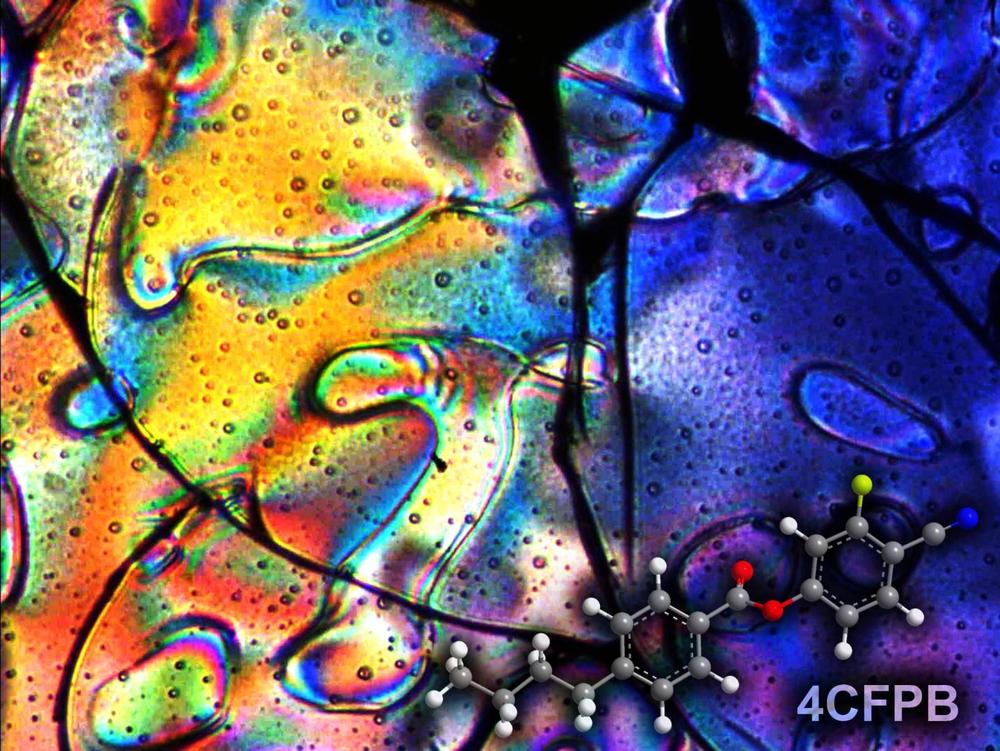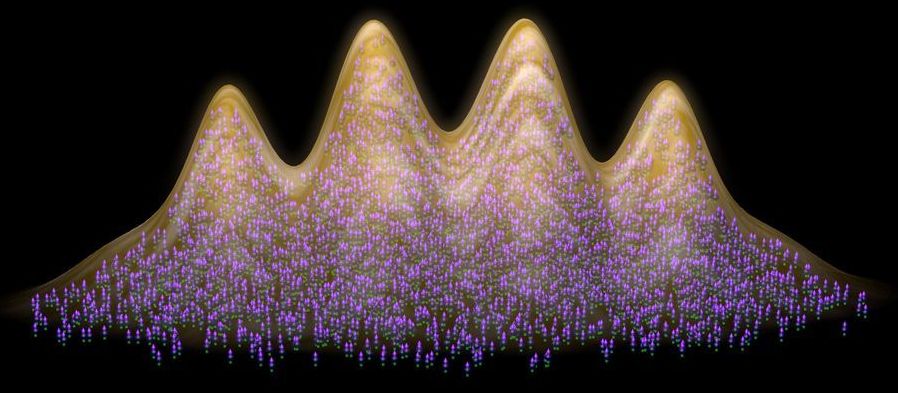Physicists thought this was impossible, until now.



Deep inside a mountain in central Italy, scientists are laying a trap for dark matter. The bait? A big metal tank full of 3.5 tons (3,200 kilograms) of pure liquid xenon. This noble gas is one of the cleanest, most radiation-proof substances on Earth, making it an ideal target for capturing some of the rarest particle interactions in the universe.
It all sounds vaguely sinister; said Christian Wittweg, a doctoral candidate at the University of Münster in Germany, who has worked with the so-called Xenon collaboration for half a decade, going to work every day feels like “paying a Bond villain a visit.” So far, the mountain-dwelling researchers haven’t captured any dark matter. But they recently succeeded in detecting one of the rarest particle interactions in the universe. [11 Biggest Unanswered Questions About Dark Matter]
According to a new study published today (April 24) in the journal Nature, the team of more than 100 researchers measured, for the first time ever, the decay of a xenon-124 atom into a tellurium 124 atom through an extremely rare process called two-neutrino double electron capture. This type of radioactive decay occurs when an atom’s nucleus absorbs two electrons from its outer electron shell simultaneously, thereby releasing a double dose of the ghostly particles called neutrinos.

Particles travelling through empty space can emit bright flashes of gamma rays by interacting with the quantum vacuum, according to a new study by researchers at the University of Strathclyde.
It has long been known that charged particles, such as electrons and protons, produce the electromagnetic equivalent of a sonic boom when their speeds exceed that of photons in the surrounding medium. This effect, known as Cherenkov emission, is responsible for the characteristic blue glow from water in a nuclear reactor, and is used to detect particles at the CERN Large Hadron Collider.
According to Einstein, nothing can travel faster than light in vacuum. Because of this, it is usually assumed that the Cherenkov emission cannot occur in vacuum. But according to quantum theory, the vacuum itself is packed full of “virtual particles”, which move momentarily in and out of existence.

University of Copenhagen researchers have developed a nanocomponent that emits light particles carrying quantum information. Less than one-tenth the width of a human hair, the miniscule component makes it possible to scale up and could ultimately reach the capabilities required for a quantum computer or quantum internet. The research result puts Denmark at the head of the pack in the quantum race.
Teams around the world are working to develop quantum technologies. The focus of researchers based at the Center for Hybrid Quantum Networks (Hy-Q) at the University of Copenhagen’s Niels Bohr Institute is on developing quantum communication technology based on light circuits, known as nanophotonic circuits. The UCPH researchers have now achieved a major advancement.
“It is a truly major result, despite the component being so tiny,” says Assistant Professor Leonardo Midolo, who has been working towards this breakthrough for the past five years.

By breaking with conventionality, University of Otago physicists have opened up new research and technology opportunities involving the basic building block of the world—atoms.
In a study, just published in Nature Communications, researchers put one atom inside each of two laser beams before moving them together until they started to interact with each other.
Co-author Associate Professor Mikkel F. Andersen, of the Department of Physics, says this allows the atoms to exchange properties in a way which could be “very useful” for future quantum technologies.

Negative pressure governs not only the Universe or the quantum vacuum. This phenomenon, although of a different nature, appears also in liquid crystals confined in nanopores. At the Institute of Nuclear Physics of the Polish Academy of Sciences in Cracow, a method has been presented that for the first time makes it possible to estimate the amount of negative pressure in spatially limited liquid crystal systems.
At first glance, negative pressure appears to be an exotic phenomenon. In fact, it is common in nature, and what’s more, occurs on many scales. On the scale of the Universe, the cosmological constant is responsible for accelerating the expansion of spacetime. In the world of plants, attracting intermolecular forces (not: expanding thermal motions) guarantee the flow of water to the treetops of all trees taller than ten metres. On the quantum scale, the pressure of virtual particles of a false vacuum leads to the creation of an attractive force, appearing, for example, between two parallel metal plates (the famous Casimir effect).
“The fact that a negative pressure appears in liquid crystals confined in nanopores was already known. However, it was not known how to measure this pressure. Although we also cannot do this directly, we have proposed a method that allows this pressure to be reliably estimated,” says Dr. Tomasz Rozwadowski from the Institute of Nuclear Physics of the Polish Academy of Sciences (IFJ PAN) in Cracow, the first author of a publication in the Journal of Molecular Liquids.

Researchers led by Francesca Ferlaino from the University of Innsbruck and the Austrian Academy of Sciences report in Physical Review X on the observation of supersolid behavior in dipolar quantum gases of erbium and dysprosium. In the dysprosium gas these properties are unprecedentedly long-lived. This sets the stage for future investigations into the nature of this exotic phase of matter.
Supersolidity is a paradoxical state where the matter is both crystallized and superfluid. Predicted 50 years ago, such a counter-intuitive phase, featuring rather antithetical properties, has been long sought in superfluid helium. However, after decades of theoretical and experimental efforts, an unambiguous proof of supersolidity in these systems is still missing. Two research teams led by Francesca Ferlaino, one at the Institute for Experimental Physics at the University of Innsbruck and one at the Institute for Quantum Optics and Quantum Information of the Austrian Academy of Sciences, now report on the observation of hallmarks of this exotic state in ultracold atomic gases.
While so far most work has focused on helium, researchers have recently turned to atomic gases—in particular, those with strong dipolar interactions. The team of Francesca Ferlaino has been investigating quantum gases made of atoms with a strong dipolar character for a long time. “Recent experiments have revealed that such gases exhibit fundamental similarities with superfluid helium,” says Lauriane Chomaz, referring to experimental achievements in Innsbruck and in Stuttgart over the last few years. “These features lay the groundwork for reaching a state where the several tens of thousands of particles of the gas spontaneously organize in a self-determined crystalline structure while sharing the same macroscopic wavefunction—hallmarks of supersolidity.”

How do you observe a process that takes more than one trillion times longer than the age of the universe? The XENON Collaboration research team did it with an instrument built to find the most elusive particle in the universe—dark matter. In a paper to be published tomorrow in the journal Nature, researchers announce that they have observed the radioactive decay of xenon-124, which has a half-life of 1.8 X 1022 years.
“We actually saw this decay happen. It’s the longest, slowest process that has ever been directly observed, and our dark matter detector was sensitive enough to measure it,” said Ethan Brown, an assistant professor of physics at Rensselaer, and co-author of the study. “It’s an amazing to have witnessed this process, and it says that our detector can measure the rarest thing ever recorded.”
The XENON Collaboration runs XENON1T, a 1,300-kilogram vat of super-pure liquid xenon shielded from cosmic rays in a cryostat submerged in water deep 1,500 meters beneath the Gran Sasso mountains of Italy. The researchers search for dark matter (which is five times more abundant than ordinary matter, but seldom interacts with ordinary matter) by recording tiny flashes of light created when particles interact with xenon inside the detector. And while XENON1T was built to capture the interaction between a dark matter particle and the nucleus of a xenon atom, the detector actually picks up signals from any interactions with the xenon.

To a non-physicist, an “atomic beam collimator” may sound like a phaser firing mystical particles. That might not be the worst metaphor to introduce a technology that researchers have now miniaturized, making it more likely to someday land in handheld devices.
Today, atomic beam collimators are mostly found in physics labs, where they shoot out atoms in a beam that produces exotic quantum phenomena and which has properties that may be useful in precision technologies. By shrinking collimators from the size of a small appliance to fit on a fingertip, researchers at the Georgia Institute of Technology want to make the technology available to engineers advancing devices like atomic clocks or accelerometers, a component found in smartphones.
“A typical device you might make out of this is a next-generation gyroscope for a precision navigation system that is independent of GPS and can be used when you’re out of satellite range in a remote region or traveling in space,” said Chandra Raman, an associate professor in Georgia Tech’s School of Physics and a co-principal investigator on the study.

The flow of granular materials, such as sand and catalytic particles used in chemical reactors, and enables a wide range of natural phenomena, from mudslides to volcanos, as well as a broad array of industrial processes, from pharmaceutical production to carbon capture. While the motion and mixing of granular matter often display striking similarities to liquids, as in moving sand dunes, avalanches, and quicksand, the physics underlying granular flows is not as well-understood as liquid flows.
Now, a recent discovery by Chris Boyce, assistant professor of chemical engineering at Columbia Engineering, explains a new family of gravitational instabilities in granular particles of different densities that are driven by a gas-channeling mechanism not seen in fluids. In collaboration with Energy and Engineering Science Professor Christoph Müller’s group at ETH Zurich, Boyce’s team observed an unexpected Rayleigh-Taylor (R-T)-like instability in which lighter grains rise through heavier grains in the form of “fingers” and “granular bubbles.” R-T instabilities, which are produced by the interactions of two fluids of different densities that do not mix—oil and water, for example—because the lighter fluid pushes aside the heavier one, have not been seen between two dry granular materials.
The study, published today in the Proceedings of the National Academy of Sciences, is the first to demonstrate that “bubbles” of lighter sand form and rise through heavier sand when the two types of sand are subject to vertical vibration and upward gas flow, similar to the bubbles that form and rise in lava lamps. The team found that, just as air and oil bubbles rise in water because they are lighter than water and do not want to mix with it, bubbles of light sand rise through heavier sand even though two types of sand like to mix.